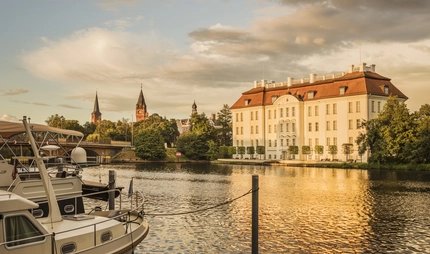
Museum im Alten Wasserwerk
A testimonial to Berlins industrial history
The Museum im Wasserwerk on Berlin's Müggelsee celebrates the two most important technical achievements of the metropolis: clean water and clean streets.
Berlin's industrial history of water supply and sewerage is a theme from the underground, and yet critical to life on the surface. Friedrichshagen on Müggelsee is Berlin's third waterwork from 1893. The museum tells the story of Berlin's water supply and urban drainage across a 19th century space stretching for approximately 7,000 square metres. Discover approximately 5,000 items including photos, drawings, plans, maps and documents. Large exhibits of pumps, tubes and cleaning equipment sprawl in the open space. Allow enough time for a guided tour that delves beneath the ground.
Fresh water for Berlin
Architect Richard Schultze and the English engineer Henry Gill build the Friedrichshagener waterworks in 1893. It is one of the largest of its kind in Europe and is an exciting testimony to Berlin's industrial culture. Visitors to the museum will be amazed by its unusual buildings. Six engine houses of red brick and their turrets are more reminiscent of a monastery than urban facilities. The museum itself is located in a disused part of the system, a former powerhouse amongst several sand filters, outbuildings and tenements. Its centrepiece is the original machine shop with an accumulation of huge wheels, tubes, boilers and pressure gauges. Look out for the steam piston engine that starts loudly. Through a tunnel-like underground passageway (only accessed on the guided tour), come into the top room with electric driven pumps. Note the control panels which are made of marble. The museum documents the history of sanitation. For centuries, waste water from the Berlin tip flows onto the road, the fetid puddles a source of disease. From 1873, this is ameliorated by the construction of a sewer system along the lines of cities such as London or Paris. By 1909 all Berlin households are connected to the network. In the wide open space of the museum, pumps, pipes and old channel cleaners recall these early feats of engineering.
Highlights of the Museum im Wasserwerk
- the great machine hall
- a steam piston machine (electric)
- historical pumps, pipes and valves
- the "underworld" of a pumping engine house
- a centrifugal space created by electric pumps
The grand cultural and sporting history of the Dahme river
About five kilometres west of the Museum im Wasserwerk, on an island in the river Dahme, stands the Baroque Köpenick Castle. This is the residence of the Brandenburg electors from the mid-16th century. The Castle is home to a branch of the Museum of the Decorative Arts. Enter a bourgeois world in its sumptuously furnished stately rooms. Bygone courtly splendour is presented in large scale tapestries, expanses of painted wall panels, fine leather wallpaper, baroque chamber cabinets and precious table centrepieces, porcelains and silver. A few kilometres away is the Water Sports Museum which showcases the world of boating and rowing on the Dahme. Take a stroll through showrooms filled with historical and modern rowing and paddle boats. Old documents, photographs, club banners and badges recall famous regattas. They celebrate East German international successes, including the 1936 Olympic Games.
Information about the Museum im Wasserwerk
Reach the museum in Treptow-Köpenick on tram line 60. Please note that you can only visit the museum as part of a guided tour. Please visit the Berliner Wasserbetriebe website for more information.


